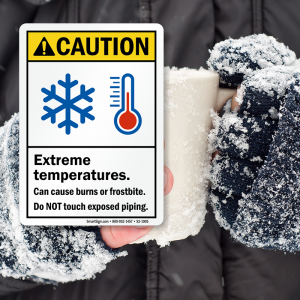
Hypothermia is when the body’s core temperature drops below 95 degrees Fahrenheit/35 Centigrade. In the U.S., at least 1500 people per year die from hypothermia. The symptoms of mild hypothermia usually include shivering and high alertness. As a worker’s body temperature falls, they may stop shivering, become confused, lose coordination, or even lose consciousness. Workers suffering from hypothermia should be taken to a warm, dry area immediately, and if conscious, should be given warm sweetened drinks to raise their body temperature. Under no circumstances should they be given alcohol. In severe cases, or if the worker is not responsive, call 911.
Frostbite is when skin tissue freezes from the outside in. The hands and feet are the most vulnerable areas to frostbite. In frostbite cases, the skin becomes numb, and feels firm; skin first becomes red, and then grey or white as cases get more severe. In worst-case scenarios, blisters may form over the skin. Workers suffering from frostbite should be treated using the hypothermia recommendations above. Do not try to break hypothermia blisters, rub the frostbitten area, or rewarm the affected area without a medical professional present.
Finally, there is trench foot. First diagnosed during World War I, trench foot is caused by long exposure to cold, damp temperatures. (Temperatures need not be below freezing to cause trench foot, as World War I soldiers found out.) Trench foot appears as foot blisters, skin swelling, blisters, and numbness. If trench foot is suspected, remove the worker’s wet footwear and socks, and dry and warm the feet. During the First World War, soldiers would use a buddy system to make sure that their buddy took off his boots and dried his feet. As always, call 911 in an emergency.
The most common preventative measures against cold stress are relatively straightforward. Dress appropriately for the cold, and avoid cotton garments in favor of wool or synthetics. Cotton fibers absorb water when wet, and make cold weather worse. Trench foot can be prevented by keeping the feet warm and dry. Engineering controls can help alleviate these problems, such as by using electric heaters in toll booths or by using temporary barriers to protect workers from the wind. Proper worker training and safety procedures also play a role. Common helpful procedures include restricting work to warmer parts of the day, having workers use a buddy system, and limiting the duties of workers who have not yet acclimated to the cold.